
|
WEB PROJECTS no.9

Mark Amerika
Grammatron
1997
 The visit of the site starts with a series of pages replacing one another without possibility of interaction, confronting the visitor with his Net surfer’s expectations and habits, inert hand on the mouse. The statements that scroll this way have to do with the experience itself, that of writing, cyberspace, the passage from practical to virtual reality. Suddenly, a labyrinthic journey is offered to the visitor, disconcerting both in content and form. Just as the visitor thinks he is moving into a certain direction and begins to assess the scope of the journey and the content of the document, the artist proposes something else, so that this experience ends up thwarting any pre-established and continually re-established concept and progressively leads the visitor to a form of keen awareness of his behaviour and the situation. A narrative thread is intercut by another, and by reflections of all kinds on the experience under way. Portions of stories are entangled and individuals, desire, identity, action are modelled by this imperceptible territory. This disproportionate work is about the passage to a digital world, depersonalization, self-construction, the place of the subjective world in the machine universe. The visit of the site starts with a series of pages replacing one another without possibility of interaction, confronting the visitor with his Net surfer’s expectations and habits, inert hand on the mouse. The statements that scroll this way have to do with the experience itself, that of writing, cyberspace, the passage from practical to virtual reality. Suddenly, a labyrinthic journey is offered to the visitor, disconcerting both in content and form. Just as the visitor thinks he is moving into a certain direction and begins to assess the scope of the journey and the content of the document, the artist proposes something else, so that this experience ends up thwarting any pre-established and continually re-established concept and progressively leads the visitor to a form of keen awareness of his behaviour and the situation. A narrative thread is intercut by another, and by reflections of all kinds on the experience under way. Portions of stories are entangled and individuals, desire, identity, action are modelled by this imperceptible territory. This disproportionate work is about the passage to a digital world, depersonalization, self-construction, the place of the subjective world in the machine universe.
(uses Java script, requires Real Audio 3.0)
S.P.
Richard Barbeau
Perec
1998
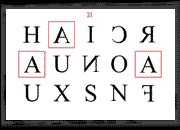 In this work, Richard Barbeau invites participants to a playful exercise inspired by Georges Perec’s famous novel, La disparition. Each of the 25 pages proposed by the artist contains a sentence to be reconstituted, always through a different process, within a grid of 25 squares in which letters are placed individually. This activity is not without recalling certain games based on language, such as crossword puzzles or scrabble, relying on the positioning of letters in space to dertermine the meaning. These paintings, connected to each other through every appearance of the letter "A" end up forming a labyrinthic structure on every page, as well as from one page to the next, thus making a fair use of both the potential of hypertext and this other text space that is the computer screen. This project meets up with Georges Perec’s work, not only by reshuffling the concept at the core of La disparition, but also by relying on defamiliarization, on a temporary confusion that results in focusing attention on language, as does Perec’s experimental writing. In the same vein, it proposes to reconquer language by reinventing our relation with it through this new communication tool that is Internet. Like in other projects of Richard Barbeau, the visual and sound character of the writing are made the most of and serve as essential ingredients to a work of progressive revelation. The artist thus passes on the joy of the adventure of language, discovery and the exploration of his new forms, as they are now made possible by the Web.
In this work, Richard Barbeau invites participants to a playful exercise inspired by Georges Perec’s famous novel, La disparition. Each of the 25 pages proposed by the artist contains a sentence to be reconstituted, always through a different process, within a grid of 25 squares in which letters are placed individually. This activity is not without recalling certain games based on language, such as crossword puzzles or scrabble, relying on the positioning of letters in space to dertermine the meaning. These paintings, connected to each other through every appearance of the letter "A" end up forming a labyrinthic structure on every page, as well as from one page to the next, thus making a fair use of both the potential of hypertext and this other text space that is the computer screen. This project meets up with Georges Perec’s work, not only by reshuffling the concept at the core of La disparition, but also by relying on defamiliarization, on a temporary confusion that results in focusing attention on language, as does Perec’s experimental writing. In the same vein, it proposes to reconquer language by reinventing our relation with it through this new communication tool that is Internet. Like in other projects of Richard Barbeau, the visual and sound character of the writing are made the most of and serve as essential ingredients to a work of progressive revelation. The artist thus passes on the joy of the adventure of language, discovery and the exploration of his new forms, as they are now made possible by the Web.
S.P.
Vera Frenkel
Body Missing
1995
 The Body Missing project was developed from an installation originally presented at Documenta IX, in Kassel Germany. Architecturally modeled as a virtual bar, the Web project is woven around the story of the uncovering of Nazi Germany’s plans for a Führermuseum in Linz. This museum would have included a number of art treasures (paintings, sculptures, prints and drawings) which had gone missing during World War II. These art works, "acquired" by suspicious means and stored in the local salt mines of Alt Aussee in a perfectly controlled environment, were found by the Allies only after the war. Body Missing is divided into six major areas: Artists; Bartenders; Beyond; Piano Players; Sources; and Video; where the public is invited to interact or eavesdrop on the various activities taking place in and around this virtual bar. The stories of those affected by World War II are complimented with those of other displaced and marginalized peoples. Frenkel has also invited numerous artists to expand on the relation of art and politics with the inclusion of their own web projects. The artists’ contributions are developed around the themes of loss and memory and permit us to explore other realities, stories, fictions and spaces. With the inclusion of artists’ collaborations Body Missing blurs reality with fantasy and memory. The project also makes further use of the research/documentary possibilities of the Web by inviting the public to contribute additional new information concerning this art theft scandal.
The Body Missing project was developed from an installation originally presented at Documenta IX, in Kassel Germany. Architecturally modeled as a virtual bar, the Web project is woven around the story of the uncovering of Nazi Germany’s plans for a Führermuseum in Linz. This museum would have included a number of art treasures (paintings, sculptures, prints and drawings) which had gone missing during World War II. These art works, "acquired" by suspicious means and stored in the local salt mines of Alt Aussee in a perfectly controlled environment, were found by the Allies only after the war. Body Missing is divided into six major areas: Artists; Bartenders; Beyond; Piano Players; Sources; and Video; where the public is invited to interact or eavesdrop on the various activities taking place in and around this virtual bar. The stories of those affected by World War II are complimented with those of other displaced and marginalized peoples. Frenkel has also invited numerous artists to expand on the relation of art and politics with the inclusion of their own web projects. The artists’ contributions are developed around the themes of loss and memory and permit us to explore other realities, stories, fictions and spaces. With the inclusion of artists’ collaborations Body Missing blurs reality with fantasy and memory. The project also makes further use of the research/documentary possibilities of the Web by inviting the public to contribute additional new information concerning this art theft scandal.
V.L.
Isabelle Hayeur
Si/jamais
1998
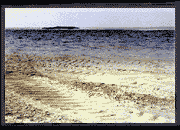 Si/jamais proposes a set of pictures from photographic source that change by "touching" or a mouse over. By a simple hand movement, everything suddenly changes, a lake is drained or a building site becomes a surging sea. The horizon, the separation, the invisible fuzzy limit in each of these images opens up, like a hidden crack, on an unsuspected counterproposal. These reversals challenge the visitor in many ways. They express the built aspect of the landscape in the field of representation and highlight the countless manipulations made possible today by digital technology. They also highlight the ambivalent attitude of the individual toward the natural world, the desire to dominate it or let oneself be submerged by it. Water, omnipresent in all the images, establishes a continuity between them and symbolizes in turn immersion, movement and life, thanks to the many metaphors it can produce. The work invites us to position ourselves on the side of the if, the possible, or the never, the definitive in our relationship with nature.
Si/jamais proposes a set of pictures from photographic source that change by "touching" or a mouse over. By a simple hand movement, everything suddenly changes, a lake is drained or a building site becomes a surging sea. The horizon, the separation, the invisible fuzzy limit in each of these images opens up, like a hidden crack, on an unsuspected counterproposal. These reversals challenge the visitor in many ways. They express the built aspect of the landscape in the field of representation and highlight the countless manipulations made possible today by digital technology. They also highlight the ambivalent attitude of the individual toward the natural world, the desire to dominate it or let oneself be submerged by it. Water, omnipresent in all the images, establishes a continuity between them and symbolizes in turn immersion, movement and life, thanks to the many metaphors it can produce. The work invites us to position ourselves on the side of the if, the possible, or the never, the definitive in our relationship with nature.
(uses Java)
S.P.
Mario Hergueta
Stop Making Sense
1997
 By means of a statement-generating program, the work invites visitors to make up sentences and insert either none, or one or two adjectives, or leave this choice at random. This activity, based on simple foundations, gives rise to an extremely instructive examination of language and its structure. The statements without adjective appear definitely more directing and authoritative while those which include epithets moderate the remarks. The integration of two adjectives quickly turns the statement into forms that are either affected or obscure. These differences are accentuated when the visitor lets the machine form sentences randomly. They succeed each other in opposition. On occasion, the machine achieves pretty amalgams, worthy of poetry. The proposals relate to art, language, technology, and offer various points of view on the world. Gradually, the artificial character of the sentences stands out and reveals the insufficiency of this automated literature. Not without humour, the work makes fun of the naive belief that the machine can eventually replace the human mind. Moreover, it casts an amused glance at the theoretical, philosophical or common considerations swamping us every day with a tone of authority.
By means of a statement-generating program, the work invites visitors to make up sentences and insert either none, or one or two adjectives, or leave this choice at random. This activity, based on simple foundations, gives rise to an extremely instructive examination of language and its structure. The statements without adjective appear definitely more directing and authoritative while those which include epithets moderate the remarks. The integration of two adjectives quickly turns the statement into forms that are either affected or obscure. These differences are accentuated when the visitor lets the machine form sentences randomly. They succeed each other in opposition. On occasion, the machine achieves pretty amalgams, worthy of poetry. The proposals relate to art, language, technology, and offer various points of view on the world. Gradually, the artificial character of the sentences stands out and reveals the insufficiency of this automated literature. Not without humour, the work makes fun of the naive belief that the machine can eventually replace the human mind. Moreover, it casts an amused glance at the theoretical, philosophical or common considerations swamping us every day with a tone of authority.
S.P.
Juliet Ann Martin
xxxoooxxx
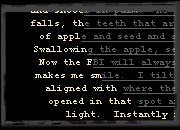 1995
1995
This work is in the tradition of calligrammes, these poems that marry a visual figure in the space referring to an element of their contents. It gathers a series of such texts that are connected and answer one another through hyperlinks. Not only do these calligrammes form silhouettes, vaguely recalling real objects, but they build trajectories that force the limits of space. Indeed, they often exceed the borders of the screen, introducing elements of surprise and expectation, extending the initial subject. This work is about the intimate relationship established with the computer, the type of expectation generated by this relationship, the projection of desire that this support can cause. Each board visually describes a state of mind, an emotion, a situation corresponding to the text, referring to the difficult passage between the organic world and the technological universe, and mixing these two realities in unexpected ways. For example, the binary code is still present in the xxxoooxxx of the title, although it refers to these "kisses and cuddles" found in greeting cards. In the same way, the apple or the sun, which are elements appearing in the texts, belong just as well to the nature as to the context of the computer (Apple, Sun). The desired intimacy cannot be achieved; the machine interposes and imposes itself, creating a tension that cannot be solved. The work is thus continuously defined by its double-entendres and sudden changes of meaning, which help create a poetic environment supported by the visual configurations and spatial trajectories.
S.P.
Melinda Rackham
a.land
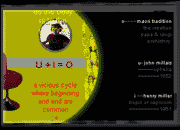 1998
1998
The travel invitation proposed by a.land takes the form of an odyssey. At the controls of his machine, the visitor sees a series of views through a circle resembling a porthole. This surface opens on images, referring to ever stranger, unfathomable landscapes. The visitor is thus thrown into worlds where the body meets the cosmos, the spectacle joins up with memory. While the horizon disappears and allusions to the real landscape along with it, the visitor dives into a dreamlike universe in which references are transformed by an interior vision. Images and texts of authors and artists mingle with this environment, which evokes in turn the underwater, lunar or uterine space. Beyond the iris that marries the contours of the window, the visitor enters increasingly deep areas where the exterior and the interior, the intimate and the immense, the real and the virtual, the past and the future, meet in an undifferentiated world. The work also touches upon the experience of immersion and self-transformation that cyberspace can generate.
(Uses Java and Java script)
S.P.
Julia Scher
Securityland
1995
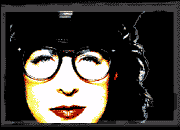 Securityland is playful exploration into of the security and observation mechanisms devised by our society. Issues of voyeurism and power as displayed through our society’s uses of surveillance technologies are the foundation for this Web project. Designed with a pop art sensibility the site is specifically gendered as feminine while also influenced by institutional architecture. During our visit we are lured into various clinical and aseptic environments containing pre-recorded voice messages that urge us to move along and direct our every exchanges and interactions within the various arenas. Featured are elaborate interactions in environments designed to remind the viewer of his/her systematized surveillance such as: The Konsent Klinic, Intrusion Detection and CCTV Control areas. This environment is an end-of millennium playground echoing a panopticon of past centuries that has been revised and re-modeled to suit our cyber-paranoid times. The potential of an outsider party to be privy to our every move and action is constantly alluded to. Various services aimed at curing our psychologically and physically ailments offered on the site (eg: Individual Insecurity Complex Retraining Code) only further emphasize a Big Brother approach to creating passive and obedient masses. Fittingly conceived for the Web, Securityland is presented in the quintessential medium of present-day paranoia, the Internet, a site notorious for fears of child stalkers, credit card theft and government surveillance. Sher’s work thus further develops issues of privacy and control already existent in Web users in a playful and self-referential manner.
Securityland is playful exploration into of the security and observation mechanisms devised by our society. Issues of voyeurism and power as displayed through our society’s uses of surveillance technologies are the foundation for this Web project. Designed with a pop art sensibility the site is specifically gendered as feminine while also influenced by institutional architecture. During our visit we are lured into various clinical and aseptic environments containing pre-recorded voice messages that urge us to move along and direct our every exchanges and interactions within the various arenas. Featured are elaborate interactions in environments designed to remind the viewer of his/her systematized surveillance such as: The Konsent Klinic, Intrusion Detection and CCTV Control areas. This environment is an end-of millennium playground echoing a panopticon of past centuries that has been revised and re-modeled to suit our cyber-paranoid times. The potential of an outsider party to be privy to our every move and action is constantly alluded to. Various services aimed at curing our psychologically and physically ailments offered on the site (eg: Individual Insecurity Complex Retraining Code) only further emphasize a Big Brother approach to creating passive and obedient masses. Fittingly conceived for the Web, Securityland is presented in the quintessential medium of present-day paranoia, the Internet, a site notorious for fears of child stalkers, credit card theft and government surveillance. Sher’s work thus further develops issues of privacy and control already existent in Web users in a playful and self-referential manner.
V.L.
Teo Spiller
Hommage to Mondrian
1999
 This project confronts the visitor with the challenge of creating his own version of a Mondrian painting, using the modern artist’s reduced vocabulary. Within the space of the screen, the visitor can thus lay out as he pleases the black lines and red, blue, yellow or white rectangles. What appears at the outset as a pleasant game becomes an exercise similar to the learning of new tools on Internet, which is often done as an autodidact, with its share of struggle, trials and errors, and mitigated results. The construction of the image seems easy at the beginning (like the common belief supposes when it comes to abstract art...), but it proves more difficult than imagined, and success is far from assured. The work deals with the possibilities of creation and the accessibility of tools on Internet, giving the illusion that, in the end "each man is an artist" (Beuys). The phenomenon of the democratization of creation becomes manifest, as well as its sometimes doubtful results. This project also refers to the tradition of visual arts with which Web art competes, an often unfavorable comparison since it does not have the same tools, the same possibilities of sophistication, the same tradition as the visual arts and the media always escapes the author’s full control. This comparison does not take account of the particular Web characteristics. This work forms part of the many works in the new media, and particularly the Internet, which make the artist an initiator, an ideator, and leave it up to participants to define the contents. This concept of art, more and more widespread, is better adapted to the Web because it takes into account the possibilities and new avenues it offers.
This project confronts the visitor with the challenge of creating his own version of a Mondrian painting, using the modern artist’s reduced vocabulary. Within the space of the screen, the visitor can thus lay out as he pleases the black lines and red, blue, yellow or white rectangles. What appears at the outset as a pleasant game becomes an exercise similar to the learning of new tools on Internet, which is often done as an autodidact, with its share of struggle, trials and errors, and mitigated results. The construction of the image seems easy at the beginning (like the common belief supposes when it comes to abstract art...), but it proves more difficult than imagined, and success is far from assured. The work deals with the possibilities of creation and the accessibility of tools on Internet, giving the illusion that, in the end "each man is an artist" (Beuys). The phenomenon of the democratization of creation becomes manifest, as well as its sometimes doubtful results. This project also refers to the tradition of visual arts with which Web art competes, an often unfavorable comparison since it does not have the same tools, the same possibilities of sophistication, the same tradition as the visual arts and the media always escapes the author’s full control. This comparison does not take account of the particular Web characteristics. This work forms part of the many works in the new media, and particularly the Internet, which make the artist an initiator, an ideator, and leave it up to participants to define the contents. This concept of art, more and more widespread, is better adapted to the Web because it takes into account the possibilities and new avenues it offers.
(Uses Java script)
S.P.
Joseph Squier
Life with Father
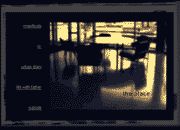 1994
1994
With Life with Father, Joseph Squier takes us into an autobiographical account whose crux is his relation with his father, and more precisely his father’s body. Every episode, from early childhood until death, recalls memories having to do with the paternal figure’s physical presence. The work tells a story made up of difficult moments, unexpressed affection, violence and loss. The treatment of the work is always adjusted to the strong emotive tension created by the account. Indeed, the text, written in a simple and direct language, makes one think of a confession, made in the greatest intimacy, and spontaneously challenges the visitor. The images, slow to download, accentuate the state of expectancy, mixed with fear and revolt. The alteration of these images intensifies the drama, while referring to past events that take another form, with time. Each episode, a page of history that the visitor turns to go on to the next, ends on a disturbing moment of suspense. The work offers us an upsetting and unique glance at the symbolic universe of men’s relation with their body. In this, it is in agreement with the media’s intimate nature, the exploration of identity it gives rise to, the memory aroused by this medium, and alludes, in its own terms, to the sensory loss following from the Web experience.
S.P.
Reviews by Valérie Lamontagne and Sylvie Parent
Translation: Jean-Pierre Fournier
|


